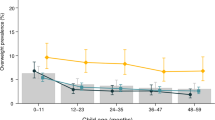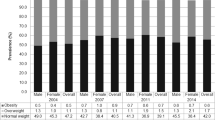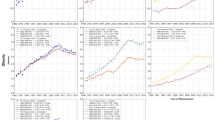Abstract
Background:
Popular media, health experts and researchers talk about a paediatric ‘obesity epidemic’ with exponentially increasing rates of obesity and overweight. However, some recent reports suggest that prevalence may have plateaued. This study examined trends in the prevalence of Australian childhood overweight and obesity since 1985. Specifically, it aimed to determine whether there have been (a) overall increases in average body mass index (BMI), (b) differential patterns of change within age groups and (c) increases in BMI within each weight-status category.
Method:
Forty-one Australian studies of childhood weight status conducted between 1985 and 2008 were reviewed. The studies included data on 264 905 Australians aged 2–18 years, with raw data being available on 70 758 children (27%). Children were classified as overweight or obese based on BMI using the criteria of Cole et al. (BMJ, 2000). The prevalence estimates were adjusted for age and sex, and plotted against measurement year using Lowess plots and two-linear-segment models. Where raw data were available, BMI z-scores (UK 1990 standard) were plotted against measurement year for all children and children in various age groups. Lowess plots and two-linear-segment models were used to assess secular trends in BMI z-scores pre- and post-1996 within age, gender and weight-status categories.
Results:
There has been a plateau, or only slight increase, in the percentage of boys and girls classified as overweight or obese, with almost no change over the last 10 years. In boys and girls, prevalence rates have settled around 21–25% for overweight and obesity together, and 5–6% for obesity alone. Similar trends were found for BMI z-scores. These patterns were fairly consistent across the age span. Within each weight-status category, average BMI has not increased.
Conclusions:
Although levels of Australian paediatric overweight remain high, the prevalence of overweight and obesity seems to have flattened and has not followed the anticipated exponential trajectory.
This is a preview of subscription content, access via your institution
Access options
Subscribe to this journal
Receive 12 print issues and online access
$259.00 per year
only $21.58 per issue
Buy this article
- Purchase on Springer Link
- Instant access to full article PDF
Prices may be subject to local taxes which are calculated during checkout




Similar content being viewed by others
References
Goran MI, Ball GD, Cruz ML . Obesity and risk of type 2 diabetes and cardiovascular disease in children and adolescents. J Clin Endocrinol Metab 2003; 88: 1417–1427.
Ebbeling CB, Pawlak DB, Ludwig DS . Childhood obesity: public-health crisis, common sense cure. Lancet 2002; 360: 473–482.
Lobstein T, Baur L, Uauy R . Obesity in children and young people: a crisis in public health. Obes Rev 2004; 5: 4–85.
Jackson-Leach R, Lobstein T . Estimated burden of paediatric obesity and co-morbidities in Europe: Part 1: the increase in prevalence of childhood obesity in Europe is itself increasing. Int J Pediatr Obes 2006; 1: 26–32.
Booth ML, Chey T, Wake M, Norton K, Hesketh K, Dollman J et al. Change in the prevalence of overweight and obesity among young Australians, 1969–1997. Am J Clin Nutr 2003; 77: 29–36.
Norton K, Dollman J, Martin M, Harten N . Descriptive epidemiology of childhood overweight and obesity in Australia: 1901–2003. Int J Pediatr Obes 2006; 1: 232–238.
O'Dea J . Inquiry into obesity in Australia. Standing Committee on Health and Ageing: Australian Government House of Representatives. Report commissioned by the Standing Committee on Health and Ageing. Australian Government House of Representatives: Canberra, 2008.
Ogden CL, Carroll MD, Flegal KM . High body mass index for age among US children and adolescents. JAMA 2008; 299: 2401–2405.
Salanave B, Péneau S, Rolland-Cachera MF, Castetbon K, Hercberg S . Prevalence of overweight in 7–9 year-old French children in 2000 and 2007 and factors associated with overweight. Obes Rev 2008; 9: S18. (abstract).
Péneau S, Salanave B, Maillard-Teyssier L, Rolland-Cachera MF, Vergnaud AC, Méjean C et al. Prevalence of overweight in 6- to 15-year-old children in central/western France from 1996 to 2006: trends toward stabilization. Int J Obes Relat Metab Disord 2009; 33: 401–407.
Sjöberg A, Lissner L, Albertsson-Wikland K, Mårild S . Recent anthropometric trends among Swedish school children: evidence for decreasing prevalence of overweight in girls. Acta Paediatr 2008; 97: 118–123.
New Zealand Ministry of Health. A Portrait of Health—Key Results of the 2006/07 New Zealand Health Survey. Ministry of Health: Wellington, New Zealand, 2008.
Cole TJ, Bellizzi MC, Flegal KM, Dietz WH . Establishing a standard definition for child overweight and obesity worldwide: international survey. BMJ 2000; 320: 1240–1243.
Olds T . Extreme physiques. In: de Ridder H, Olds T (eds). Kinanthropometry 7. Potchefstroom University for Christian Higher Education: Potchefstroom, 2003. pp 9–34.
Cole TJ, Freeman JV, Preece MA . Body mass index reference curves for the UK, 1990. Arch Dis Child 1995; 73: 25–29.
Cheng B, Kuipers H, Snyder AC, Keizer HA, Heukendrup A, Hesselink M . A new approach to the determination of ventilatory and lactate thresholds. Int J Sports Med 1992; 13: 518–522.
Zar JH . Biostatistical Analysis. 4th edn. Prentice Hall: Upper Saddle River, NJ, 1999.
Grimmer K, Williams M . Gender-age environmental associates of adolescent low back pain. Appl Ergon 2000; 31: 343–360.
Sanigorski AM, Bell AC, Kremer PJ, Cuttler R, Swinburn BA . Reducing unhealthy weight gain in children through community capacity-building: results of a quasi-experimental intervention program, be active eat well. Int J Obes 2008; 32: 1060–1067.
Telford RD, Cunningham RB, Daly RM, Reynolds GJ, Lafferty AR, Gravenmaker KJ et al. Discordance of international adiposity classifications in Australian boys and girls—the LOOK study. Ann Hum Biol 2008; 35: 334–341.
Lunner K, Wertheim EH, Thompson JK, Paxton SJ, Mc Donald F, Halvaarson KS . A cross-cultural examination of weight-related teasing, body image, and eating disturbance in Swedish and Australian samples. Int J Eat Disord 2000; 28: 430–435.
Patton GC, Selzer R, Coffey C, Carlin JB, Wolfe R . Onset of adolescent eating disorders: population based cohort study over 3 years. BMJ 1999; 318: 765–768.
Spinks AB, Macpherson AK, Bain C, Mc Clure RJ . Compliance with the Australian national physical activity guidelines for children: relationship to overweight status. J Sci Med Sport 2007; 10: 156–163.
van den Berg P, Wertheim EH, Thompson JK, Paxton SJ . Development of body image, eating disturbance, and general psychological functioning in adolescent females: a replication using covariance structure modeling in an Australian sample. Int J Eat Disord 2002; 32: 46–51.
Vivanti A, Sheffield J . Height, weight and body mass index distribution data for Queensland schoolchildren aged ten to 18 years. Aust J Nutr Diet 2001; 58: 121–127.
Vaska V, Volkmer R . Increasing prevalence of obesity in South Australian 4-year-olds: 1995–2002. J Paediatr Child Health 2004; 40: 353–355.
Zuo Y, Norberg M, Wen LM, Rissel C . Estimates of overweight and obesity among samples of preschool-aged children in Melbourne and Sydney. Nutr Diet 2006; 63: 179–182.
Vincent SD, Pangrazi RP, Raustorp A, Tomson LM, Cuddihy TF . Activity levels and body mass index of children in the United States, Sweden, and Australia. Med Sci Sports Exerc 2003; 35: 1367–1373.
Australian Council for Health, Physical Education and Recreation. Australian Fitness Education Award: User's Manual and Curriculum Ideas. Australian Council for Health, Physical Education and Recreation: Adelaide, 1996.
Pyke JE . Australian Health and Fitness Survey 1985. The Australian Council for Health, Physical Education and Recreation: Adelaide, 1987.
Burke V, Beilin L, Durkin K, Striktke WGK, Houghton S, Cameron CA . Television, computer use, physical activity, diet and fatness in Australian adolescents. Int J Pediatr Obes 2006; 1: 248–255.
Hands B, Parker H, Glasson C, Brinkman S, Read H . Physical Activity and Nutrition Levels in Western Australian Children and Adolescents: Report. Western Australian Government: Perth, 2004.
Timperio A, Salmon J, Telford A, Crawford D . Perceptions of local neighbourhood environments and their relationship to childhood overweight and obesity. Int J Obes 2005; 29: 170–175.
Dollman J, Pilgrim A . Changes in body composition between 1997 and 2002 among South Australian children: influences of socio-economic status and location of residence. Aust N Z J Public Health 2005; 29: 166–170.
Dollman J, Olds TS, Norton KI, Stuart DB . The evolution of fitness and fatness in 10–11 year old Australian schoolchildren. Pediatr Exerc Sci 1999; 11: 108–121.
Hands B . Fitness and Motor Skill Levels of Western Australian Primary School Children. University of Western Australia: Perth, 2000.
Abbott RA, Macdonald D, Mackinnon L, Stubbs CO, Lee AJ, Harper C et al. Healthy Kids Queensland Survey 2006—Summary Report. Queensland Health: Brisbane, 2007.
Salmon J, Timperio A, Cleland V, Venn A . Trends in children's physical activity and weight status in high and low socio-economic status areas of Melbourne, Victoria, 1985–2001. Aust N Z J Public Health 2005; 29: 339–342.
Birchall J . Health-related fitness testing. In: Went S (ed). A Healthy Start: Holistic Approaches to Health Promotion in School Communities. Monash University: Melbourne, 1991. pp 251–265.
Wake M, Hesketh K, Waters E . Television, computer use and body mass index in Australian primary school children. J Paediatr Child Health 2003; 39: 134–140.
Wake M, Hardy P, Canterford L, Carlin JB . Overweight, obesity and girth of Australian preschoolers: prevalence and socio-economic correlates. Int J Obes 2007; 31: 1044–1051.
Australian Institute of Family Studies. Growing Up in Australia: The Longitudinal Study of Australian Children, Data Wave 2.5 CD ROM, Australian Institute of Family Studies: Melbourne, 2007.
Department of Health and Ageing. 2007 Australian National Children's Nutrition and Physical Activity Survey—Main Findings. Department of Health and Ageing: Canberra, 2008.
Australian Bureau of Statistics. 1995 National Nutrition Survey (NNS) Confidentialized Unit Record File (CURF). Commonwealth of Australia: Canberra, 1999.
O'Dea JA . Gender, ethnicity, culture and social class influences on childhood obesity among Ausgtralian schoolchildren: implications for treatment, prevention and community education. Health Soc Care Community 2008; 16: 282–290.
O'Dea JA . Differences in overweight and obesity among Australian schoolchildren of low and middle/high socioeconomic status [letter]. Med J Aust 2003; 179: 63.
Rehor P, Cottam BJ . Physical activity levels of northern Tasmanian high school students. ACHPER Healthy Lifestyles J 2000; 47: 14–17.
Booth M, Macaskill P, McLellan L, Phongsavan P, Okely AD, Patterson J . NSW Schools Fitness and Physical Activity Survey. NSW Department of School Education: Sydney, 1997.
Booth M, Okely D, Denney-Wilson E, Hardy L, Yang B, Dobbins T . NSW Schools Physical Activity and Nutrition Survey (SPANS) 2004: Summary Report. NSW Department of Health: Sydney, 2006.
Tomkinson GR, Olds TS . Secular changes in pediatric aerobic fitness test performance: the global picture. In: Tomkinson GR, Olds TS (eds). Pediatric Fitness: Secular Trends and Geographic Variability (Vol 50, Medicine and Sport Science Series). Karger: Basel, 2007.
Tomkinson GR, Léger L, Olds T, Cazorla G . Secular trends in the fitness of children and adolescents 1980–2000—an analysis of 20 m shuttle run studies. Sports Med 2003; 33: 385–400.
Olds T, Wake M, Patton G, Ridley K, Waters E, Williams J et al. How do school-day activity patterns differ with age and sex across adolescence? J Adolesc Health 2008; corrected proof: published online 31 July.
Australian Bureau of Statistics. National Health Survey: 2004–2005 Summary of Results. Australian Government Publishing Service: Canberra, 2005.
Barr ELM, Magliano DJ, Zimmet PZ, Polkinghorne KR, Atkins RC, Dunstan DW et al. Ausdiab 2005: The Australian Diabetes, Obesity and Lifestyle Study. Tracking the Accelerating Epidemic: Its Causes and Outcomes. International Diabetes Institute: Melbourne, 2006.
Okely A, Booth M, Hardy L, Dobbins T, Denney-Wilson E . Changes in physical activity participation from 1985 to 2004 in a statewide survey of Australian adolescents. Arch Pediatr Adolesc Med 2008; 162: 176–180.
Mårild S, Bondestam M, Bergström R, Ehnberg S, Hollsing A, Albertsson-Wikland K . Prevalence trends of obesity and overweight among 10-year-old children in western Sweden and relationship with parental body mass index. Acta Paediatr Scand 2004; 93: 1588–1595.
Kelishadi R . Childhood overweight, obesity, and the metabolic syndrome in developing countries. Epidemiol Rev 2007; 29: 62–76.
Popkin BM . Global nutrition dynamics: the world is shifting rapidly toward a diet linked with noncommunicable diseases. Am J Clin Nutr 2006; 84: 289–298.
Woolcott Research. Evaluation of the National ‘Get Moving’ Campaign. Australian Government Department of Health and Ageing: Canberra, Australia, 2007.
Australian Sports Commission. Helping Kids and Communities Get Active: An Interim Report of the Evaluation of the Australian Sports Commission's Active After-School Communities Program 2005–2007. Australian Sports Commission: Canberra, Australia, 2008.
Australian Government Department of Health and Ageing. Stephanie Alexander Kitchen Garden National Program. 2008. http://www.healthyactive.gov.au/internet/healthyactive/publishing.nsf/Content/kitchen-garden, Accessed 28 July 2009.
Dollman J, Olds TS . Secular changes in fatness and fat distribution in Australian children matched for body size. Int J Pediatr Obes 2006; 1: 109–113.
Gard M, Wright J . The Obesity Epidemic: Science, Morality and Ideology. Routledge: London, 2005.
Acknowledgements
We thank the following researchers for their generosity in providing raw data for this study: Rebecca Abbott (Queensland Health and the University of Queensland), Michael Booth, Valerie Burke, Carolyn Coffey, Jim Dollman, Jeff Emmel (Australian Council for Health, Physical Education and Recreation), Beth Hands, Peter Kremer, Rod McClure, George Patton, Jo Salmon, Andrea Sanigorski, Jeanie Sheffield, Anneliese Spinks, Boyd Swinburn, Amanda Telford, Richard Telford, Rohan Telford, Angela Vivanti, Bob Volkmer, Melissa Wake, Eleanor Wertheim and Marie Williams. We also thank Mr John Petkov for statistical advice. No financial support was received for this study. However, some of the included data were from a survey supported by the Australian Commonwealth Department of Health and Ageing; the Department of Agriculture, Fisheries and Forestry and the Australian Food and Grocery Council.
Author information
Authors and Affiliations
Corresponding author
Rights and permissions
About this article
Cite this article
Olds, T., Tomkinson, G., Ferrar, K. et al. Trends in the prevalence of childhood overweight and obesity in Australia between 1985 and 2008. Int J Obes 34, 57–66 (2010). https://doi.org/10.1038/ijo.2009.211
Received:
Revised:
Accepted:
Published:
Issue Date:
DOI: https://doi.org/10.1038/ijo.2009.211
Keywords
This article is cited by
-
Further reductions in the prevalence of obesity in 4-year-old New Zealand children from 2017 to 2019
International Journal of Obesity (2022)
-
The effect of height on estimates of the change in BMI-based prevalence of childhood obesity
International Journal of Obesity (2021)
-
High prevalence of undiagnosed comorbidities among adolescents with obesity
Scientific Reports (2020)
-
Psychosocial measures and weight change in a clinical paediatric population with obesity
Quality of Life Research (2019)
-
Predictive utility of childhood anthropometric measures on adult glucose homeostasis measures: a 20-year cohort study
International Journal of Obesity (2018)



